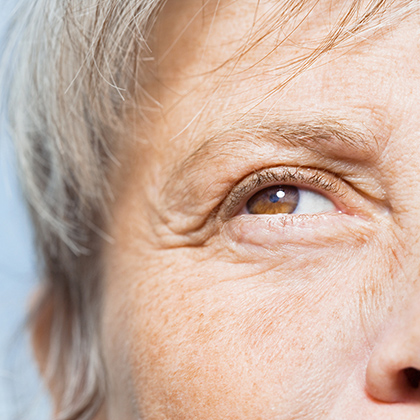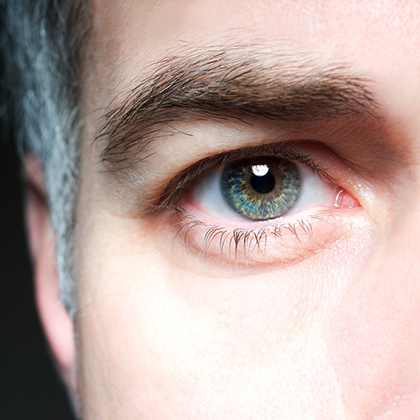Worldwide, cataracts are one of the two most common causes of vision impairment (i), with around one in three people aged 65 or older in the UK thought to be affected by them (ii). But what exactly are cataracts? When the lens in your eye becomes cloudy, it’s called a cataract. The cloudiness affects your vision, making it blurry in general, or you may have areas of your vision that look misty and less clear. And while there are rare types of cataracts that affect children and babies, the vast majority of cases affect older people.
Cataracts usually develop gradually, so you may not notice you have a problem for several years. But over time, your vision will become cloudier. And while blurred or cloudy vision is the main symptom of cataracts, they can affect your vision in other ways too. For instance, you may see colours less brightly or less clearly and more yellowish; you may have double vision; or you may find it more difficult to see clearly in dim or very bright light. Some people also notice visual effects such as halos around bright lights (car headlights, for example), or they may find bright lights too bright or dazzling. If you have cataracts, you may also discover that any prescription glasses you wear start to become less effective.
What causes cataracts
Nobody knows what really causes cataracts, and most people who are affected develop them for no apparent reason. Age is the most common risk factor, but according to the Royal National Institute for Blind People (RNIB), the following are also thought to be involved in the development of cataracts (iii):
-
Uveitis (a condition causing inflammation in the middle layer of the eye)
-
Certain medicines taken long term, such as steroids
-
Trauma to the eye (such as an injury)
-
Eye surgery for other conditions
-
Other eye conditions, such as retinitis
-
Family history of cataracts
Your lifestyle may also put you at risk, as a diet lacking in antioxidant vitamins, drinking excessive amounts of alcohol on a regular basis, smoking and lifelong exposure to sunlight are all thought to play a part in cataract development. Find out handy tips on subjects such as how to stop smoking here.
If you have problems with your vision, your optician or GP can tell whether or not you have cataracts by examining your eyes. If you have mild cataracts, you may just need stronger glasses to begin with. But in time, it’s likely you’ll need treatment in the form of cataract surgery.
How your eyes work
There are several parts of your eyes that work together, allowing you to see:
-
Cornea
The cornea is the outer coating of the front of your eye, covering the pupil and the iris. When you look at something, the light reflected off it passes through the cornea and then the lens, where it is focused onto the retina. -
Iris
This is the coloured part of your eye (the white part is called the sclera). The iris changes the size of the pupil, allowing more or less light to enter the eye. -
Pupil
The pupil is the dark circular hole at the centre of the iris. Light passes through the pupil – which expands and contracts, depending on how much light there is – and onto the lens. -
Lens
Sitting behind the iris, the lens focuses light that has passed through via the pupil onto the retina. The lens is normally clear and transparent, and changes shape to focus on objects that are closer or more distant. As you get older, this ability to change shape often deteriorates, which is why you may need glasses for reading. The lens can become cloudy with age too, causing cataracts. If you have cataracts, light can’t pass through the lens properly, and the result will be problems with your vision. -
Retina
The retina lines the back of the eye and converts light from the lens into signals that are sent to the brain via a network of nerves from different parts of the retina and then via the optic nerve. The brain receives and interprets these signals, allowing you to see. -
Macula
This is a small area at the centre of the retina that allows you to see what’s directly in front of you as well as fine detail. -
Vitreous
The vitreous is a clear jelly-like substance that fills the inside of the eye from the lens to the retina.
Cataract surgery Q&As
When do you usually need surgery to remove cataracts?
Cataract surgery is available on the NHS, but only when the deterioration in your vision has reached a point where it makes carrying out daily activities difficult. You can pay to have the operation privately at an earlier stage.
What happens during cataract surgery?
Surgery is performed on one eye – usually your non-dominant eye first – and then the other at a later date. The operation takes around 30-40 minutes, and most people go home a few hours afterwards. It’s usually performed under a local anaesthetic, which means you’ll be conscious during the procedure. However, this is nothing to worry about, as the anaesthetic used is very effective, and you shouldn’t feel (or even see) a thing.
The procedure involves making a tiny incision in your eye. The cloudy lens in your eye is broken down using an instrument emitting ultrasound waves, then removed by gentle suction. Then a new plastic lens is placed inside the membrane that held your original lens, called the lens capsule. The incision is so small, most people don’t need stitches – though you may have to wear a pad over your eye after the operation and use drops to reduce the chance of infection as well as to reduce any inflammation for a while afterwards.
Is cataract surgery safe?
More than 300,000 cataract operations are carried out every year in the UK (ii), making it the most common surgical procedure in this country. The surgery itself is generally very successful, but a very small number of people who have the operation will experience complications.
The most common complication is a thickening of the lens capsule that holds the lens in place. It can happen months or even years after you had surgery, and it means your vision will start to become cloudy again. The good news is the thickening – called posterior capsule opacification – can be easily corrected with a minor laser operation.
Other complications are rare and include retinal detachment, infection or problems with the lens implant. Again, these can all be treated.
How long does it take to recover?
Many people find their vision has improved just one or two days after having surgery, though it may take a little longer to see completely clearly as any inflammation following the surgery may need time to subside. You should feel fine after a good night’s sleep, and can resume your day-to-day activities as soon as you feel able. However, you should avoid strenuous exercise, swimming and rubbing your eye for a while – your optician will advise you. If you wear eye make-up, you may have to stop for a while too, until your optician says it’s safe to use make-up again.
Can cataracts be prevented?
It’s debatable whether cataracts are inevitable or whether they may be avoided. However, there are steps you can take that may reduce your risk of developing them as you get older or that may slow up their development
Watch what you eat
Not eating enough foods containing important antioxidant vitamins – including fruit and vegetables – is thought to play a part in cataract development (iv). Try to get plenty of dark green and colourful fruit and veg in your diet – at least five portions every day – and have at least two weekly portions of fish (one of which should be oily). Drink plenty of water and avoid eating too many foods that contain high levels of saturated fats (mostly found in meat, dairy and other animal-sourced foods), salt and refined sugars.
Curb smoking and excessive drinking
Smoking is believed to increase your risk of developing cataracts (v), so if you haven’t done so already, think seriously about giving up. According to the NHS, regularly drinking excessive amounts of alcohol may also increase your cataract risk (v), so try to keep within recommended daily intake limits (currently this is no more than 14 units of alcohol a week on a regular basis for adults).
Get plenty of sleep
Sleeping may also help because it gives your eyes a chance to rest and to recover from the stresses of the day (try to make your bedroom as dark as possible so that your eyes can rest as effectively as possible).
Protect your eyes from the sun
Many experts believe cataracts are linked to UV exposure (vi), so protect yourself by wearing good-quality sunglasses, not just during the summer but on bright autumn and winter days too. Look out for glasses that carry the CE mark or British Standard BS EN ISO 12312-1:2013 to get adequate protection. Whenever you’re in intense sunlight – during your summer holidays, for instance – try to wear a hat with a wide brim when the sun is at its strongest (usually between 10am and 3pm), as it can make your eyes less exposed to UVB rays. Take these steps to protect your eyes even when you’re in the shade, as the sun’s rays are highly reflective and sitting in the shade without sunglasses or a hat may not give you the protection you need.
Get your eyes tested
A 30-minute eye examination could help by picking up problems such as cataracts. Even if you don’t think there’s anything wrong, an optician may see the early stages of cataracts before they’ve started to affect your vision. Currently, a two-yearly eye test is recommended for most people. However, if you are aged 40 or older and in an at-risk group for an eye condition (if you have a family history of eye conditions, for instance) you should have an eye test at least every two years.
Natural ways to boost your vision
There are several natural supplements that support eye health in general, most notably those that contain antioxidants. Some observational studies even suggest people who have a high intake of antioxidants may be less likely to develop cataracts than those who eat fewer antioxidants (vii). Here are some you may like to try.
Green tea
Supplements based on green tea extract contain antioxidants called catechin polyphenols. In fact, tea is believed to have around eight to 10 times the amount of polyphenols found in fruit and vegetables (viii).
Lutein
A plant chemical found in green vegetables, lutein belongs to the carotenoid group of antioxidants, and is thought to protect cells against the damage caused by free radicals. It is also the main pigment found in the centre of the eye’s retina, known as the macula. Experts have discovered that lutein may act as a natural eye shade and protect the retina against too much light (ix). It may also have a protective effect on the lens, and studies have found that people who eat foods containing lutein are less likely to develop cataracts (x).
High-strength antioxidants
Other supplements containing antioxidants include high-strength multivitamin and mineral tablets containing vitamins C, D, E plus the minerals zinc and selenium. Products that contain nutrients with high ORAC values also offer good levels of polyphenols (ORAC stands for oxygen radical absorbance capacity and is a method of measuring antioxidant levels in food – the higher the ORAC value, the higher the level of antioxidants in any particular food).
Astaxanthin
This is also a carotenoid antioxidant, with researchers having found it’s a particularly potent one (xi). Animal studies also suggest astaxanthin may help prevent the lens cloudiness that’s characteristic of cataracts (xii), though unfortunately human studies – which are far more relevant than animal trials – are as yet still lacking.
Astaxanthin is derived from a freshwater microalgae called Haematococcus pluvialis, and is the red pigment in the algae that gives fish and shellfish like salmon and lobster their distinctive red/pink colour.
You can get astaxanthin in your diet by eating foods such as salmon, lobster, shrimp, crawfish and crab. However it’s unlikely that you’d be able to eat enough to get the amount of astaxanthin needed to see any vision benefits. Taking a high-quality supplement, however, would provide a more beneficial dose of astaxanthin – plus it’s the perfect option for anyone who’s not keen on fish or seafood.
Read more about astaxanthin and its other benefits for eye health here.
Fish Oils
Omega-3 fatty acids found in fish oils – namely docosahexaenoic acid (DHA) and eicosapentaenoic acid (EPA) – may also benefit eye health. For instance, DHA is naturally found in high concentrations in the retina of the eye, and may be necessary for maintaining healthy eye function.
If you don’t like eating fish you can get your supply of EPA and DHA by taking a good-quality fish oil supplement. Meanwhile if you’re a vegetarian or vegan you can still benefit from an omega-3 supplement, thanks to the availability of products that contain the natural triglyceride (TG) form of omega-3. This is sourced from plant organisms called microalgae rather than fish.
Cataracts can be a worrying condition, but following the steps above can help you mitigate the effects of this common condition. Find out how to manage other common health conditions by visiting our health library.
References:
-
Available online: https://www.who.int/news-room/fact-sheets/detail/blindness-and-visual-impairment
-
Available online: https://patient.info/eye-care/visual-problems/cataracts#nav-1
-
Available online: https://www.rnib.org.uk/eye-health/eye-conditions/cataracts
-
Available online: https://www.aoa.org/patients-and-public/caring-for-your-vision/nutrition/nutrition-and-cataracts
-
Available online: https://www.nhs.uk/conditions/cataracts/
-
Available online: https://patient.info/doctor/cataracts-and-cataract-surgery#nav-1
-
Bungau S. et al., Health Benefits of Polyphenols and Carotenoids in Age-Related Eye Diseases. Oxid Med Cell Longev.9783429.Available online: https://www.hindawi.com/journals/omcl/2019/9783429/
Hong Jiang M. et al., Dietary Vitamin and Carotenoid Intake and Risk of Age-Related Cataract. Am J Clin Nutr. 2019;109(1):43-54.Available online: https://pubmed.ncbi.nlm.nih.gov/30624584-dietary-vitamin-and-carotenoid-intake-and-risk-of-age-related-cataract/
Tavani. A, Negri. E, La Vecchia. C. Food and nutrient intake and risk of cataract. Ann Epidemiol. 1996;6:41-46. Available online: https://pubmed.ncbi.nlm.nih.gov/8680624-food-and-nutrient-intake-and-risk-of-cataract/
Chasan-Taber. L, Willett. WC, Weddon. JM, et al. A prospective study of carotenoid and vitamin A intakes and risk of cataract extraction in US women. Am J Clin Nutr. 1999;70:509-516. Available online: https://pubmed.ncbi.nlm.nih.gov/10500020-a-prospective-study-of-carotenoid-and-vitamin-a-intakes-and-risk-of-cataract-extraction-in-us-women/
Higuera-Ciapara. I, Felix-Valenzuela. L, Goycoolea. FM. Astaxanthin: a review of its chemistry and applications. Crit Rev Food Sci Nutr. 2006;46:185-96. Available online: https://pubmed.ncbi.nlm.nih.gov/16431409-astaxanthin-a-review-of-its-chemistry-and-applications/ -
Available online: https://www.webmd.com/food-recipes/features/antioxidants-in-green-and-black-tea#1
-
Landrum. JT, Bone. RA, Kilburn. MD. The macular pigment: a possible role in protection from age-related macular degeneration. Adv Pharmacol. 1997;38:537-556.
-
Hankinson. SE, Stampfer. MJ, Seddon. JM, et al. Nutrient intake and cataract extraction in women: a prospective study. BMJ. 1992;305:335-339.
Christen WG. et al., Dietary Carotenoids, Vitamins C and E, and Risk of Cataract in Women: A Prospective Study. Arch Opthalmol. 2008;126(1):102-9.Available online: https://pubmed.ncbi.nlm.nih.gov/18195226-dietary-carotenoids-vitamins-c-and-e-and-risk-of-cataract-in-women-a-prospective-study/?dopt=Abstract -
Miki W. et al., Biological functions and activities of animal carotenoids. Pure Appl. Chem. 1991;63:141-6. Available online: https://www.researchgate.net/publication/244741723_Biological_Functions_and_Activities_of_Animal_Carotenoids
-
Giannaccare G. et al., Clinical Applications of Astaxanthin in the Treatment of Ocular Diseases: Emerging Insights. Mar Drugs. 2020 May;18(5):239.
Related Posts
Disclaimer: The information presented by Nature's Best is for informational purposes only. It is based on scientific studies (human, animal, or in vitro), clinical experience, or traditional usage as cited in each article. The results reported may not necessarily occur in all individuals. Self-treatment is not recommended for life-threatening conditions that require medical treatment under a doctor's care. For many of the conditions discussed, treatment with prescription or over the counter medication is also available. Consult your doctor, practitioner, and/or pharmacist for any health problem and before using any supplements or before making any changes in prescribed medications.

Christine
Christine Morgan has been a freelance health and wellbeing journalist for almost 20 years, having written for numerous publications including the Daily Mirror, S Magazine, Top Sante, Healthy, Woman & Home, Zest, Allergy, Healthy Times and Pregnancy & Birth; she has also edited several titles such as Women’ Health, Shine’s Real Health & Beauty and All About Health.
View More



